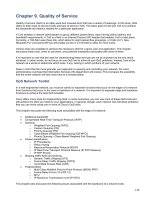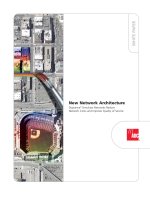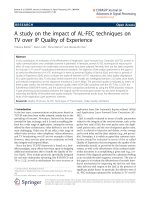IP quality of service
Bạn đang xem bản rút gọn của tài liệu. Xem và tải ngay bản đầy đủ của tài liệu tại đây (807.36 KB, 91 trang )
IP Quality of Service
Objectives
Upon completing this module, you will be able to:
Describe the need for IP QoS
Describe the Integrated Services model
Describe the Differentiated Services model
Describe the building blocks of IP QoS mechanisms (classification,
marking, metering, policing, shaping, dropping, forwarding, queuing)
Inner Mongolia University
Introduction
Objectives
Upon completing this lesson, you will be able to:
Describe different types of applications and services that have
special resource requirements
List the network components that affect the throughput, delay,
and jitter in IP networks
List the benefits of deploying QoS mechanisms in IP networks
Describe typical enterprise and service provider networks and
their QoS-related requirements
Inner Mongolia University
Why IP QoS?
Application X is slow.
Video broadcast occasionally stalls.
Phone calls over IP are no better than over satellite.
Phone calls can have very bad voice quality.
ATMs (the money-dispensing type) are
nonresponsive.
5
Inner Mongolia University
Because ...
Application X is slow!
(not enough bandwidth)
Video broadcast occasionally stalls!
(delay temporarily increases – jitter)
Phone calls over IP are no better than over satellite! (too
much delay)
Phone calls can have very bad voice quality!
(too many phone calls – admission control)
ATMs (the money-dispensing type) are nonresponsive!
(too many drops)
6
Inner Mongolia University
What Causes ...
Lack of bandwidth?: Multiple flows are contesting for
a limited amount of bandwidth.
Too much delay?: Packets have to traverse many
network devices and links.
Variable delay?: Sometimes there is a lot of other
traffic, which results in more delay.
Drops?: Packets have to be dropped when a link is
congested.
7
Inner Mongolia University
Available Bandwidth
IP
IP
IP
IP
512 kbps
256 kbps
10 Mbps
100 Mbps
BWmax = min(10M, 256k, 512k, 100M)=256 kbps
BWavail = BWmax /Flows
Maximum available bandwidth equals the bandwidth of the
weakest link.
Multiple flows are competing for the same bandwidth, resulting in much less
bandwidth being available to one single application.
8
Inner Mongolia University
End-to-End Delay
IP
IP
Propagation
Delay (P1)
Processing and
Queuing Delay (Q1)
IP
Propagation
Delay (P2)
Processing and
Queuing Delay (Q2)
IP
Propagation
Delay (P3)
Propagation
Delay (P4)
Processing and
Queuing Delay (Q3)
Delay = P1 + Q1 + P2 + Q2 + P3 + Q3 + P4 = X ms
End-to-end delay equals a sum of all propagation, processing, and
queuing delays in the path.
Propagation delay is fixed; processing and queuing delays are
unpredictable in best-effort networks.
9
Inner Mongolia University
Processing, Queuing, and
Propagation Delay
IP
IP
Processing Delay
IP
Bandwidth
Forwarding
IP
Queuing Delay
Propagation Delay
Processing delay is the time it takes for a router to take the packet from an input
interface and put it into the output queue of the output interface.
Queuing delay is the time a packet resides in the output queue of a router.
Propagation or serialization delay is the time it takes to transmit a packet.
10
Inner Mongolia University
Packet Loss
Forwarding
IP
IP
IP
IP
IP
Tail-drop
Tail-drops occur when the output queue is full. These are the most common
drops which happen when a link is congested.
There are also many other types of drops (input queue drop, ignore, overrun, no
buffer, etc), which are not as common and which may require a hardware
upgrade. These drops are usually a result of router congestion.
11
Inner Mongolia University
How to Increase Available
Bandwidth?
TCP Header Compression
RTP Header Compression
cTCP Data
Compress
the Headers
IP
TCP
FIFO queuing
Fancy
Queuing
Data
Compress
the Payload
Compressed Packet
Stacker
Predictor
Priority Queuing (PQ)
Custom Queuing (CQ)
Modified Deficit Round Robin (MDRR)
Class-Based Weighted Fair Queing (CBWFQ)
Upgrade the link—the best solution but also the most expensive.
• Take some bandwidth from less important applications.
• Compress the payload of Layer 2 frames.
• Compress the header of IP packets.
12
Inner Mongolia University
How to Reduce Delay?
TCP Header Compression
RTP Header Compression
cRTP Data
Compress
the Headers
IP
UDP RTP
FIFO queuing
Fancy
Queuing
Data
Compress
the Payload
Compressed Packet
Stacker
Predictor
Priority Queuing (PQ)
Custom Queuing (CQ)
Strict Priority MDRR
IP RTP Prioritization
Class-Based Low-Latency Queuing (CBLLQ)
Upgrade the link—the best solution but also the most expensive.
• Forward the important packets first.
• Compress the payload of Layer-2 frames (it takes time).
• Compress the header of IP packets.
13
Inner Mongolia University
How to Prevent Packet Loss?
Weighted Random Early Detection (WRED)
IP
Data
Dropper
Fancy
Queuing
FIFO queuing
Custom Queuing (CQ)
Modified Deficit Round Robin (MDRR)
Class-Based Weighted Fair Queuing (CBWFQ)
Upgrade the link—the best solution but also the most expensive.
• Guarantee enough bandwidth to sensitive packets.
• Prevent congestion by randomly dropping less important packets
before congestion occurs.
14
Inner Mongolia University
Which Applications Have Which QoS
Requirements?
Throughput
Delay
Loss
Jitter
Interactive
(e.g., Telnet)
Low
Low
Low
Not
Important
Batch (e.g.,
FTP)
High
Not
Important
Low
Not
Important
Fragile (e.g,.
SNA)
Low
Low
None
Not
Important
Voice
Low
Low and
Predictable
Low
Low
Video
High
Low and
Predictable
Low
Low
Enterprise networks are typically focused on providing QoS to
applications.
15
Inner Mongolia University
Which Services Can Be
Implemented in a Network?
Throughput
Delay
Loss
Jitter
Gold
Guaranteed
Low
Low
Low
Silver
Guaranteed
No
Guarantee
No
Guarantee
No
Guarantee
Bronze
Guaranteed
Limited
No
Guarantee
No
Guarantee
No
Guarantee
No
Guarantee
No
Guarantee
No
Guarantee
No
Guarantee
Best Effort
Service provider networks typically offer services based on
source and destination addresses.
16
Inner Mongolia University
How Can QoS Be Applied?
Best effort—no QoS is applied to packets (default
behavior)
Integrated Services model—applications signal to the
network that they require special QoS
Differentiated Services model—the network
recognizes classes that require special QoS
17
Inner Mongolia University
Summary
Upon completing this lesson, you should be able
to:
Describe different types of applications and services that have
special resource requirements
List the network components that affect the throughput, delay,
and jitter in IP networks
List the benefits of deploying QoS mechanisms in IP networks
Describe typical enterprise and service provider networks and
their QoS-related requirements
Inner Mongolia University
Review Questions
1.What are the relevant parameters that define quality
of service?
2.What can be done to give more bandwidth to an
application?
3.What can be done to reduce delay?
4.What can be done to prevent packet loss?
5.Name the two QoS models.
Inner Mongolia University
Integrated Services
Model
Objectives
Upon completing this lesson, you will be
able to:
Describe the IntServ model
List the key benefits and drawbacks of the IntServ
model
List some implementations that are based on the
IntServ model
Describe the need for Common Open Policy Service
(COPS)
Inner Mongolia University
Integrated Services
The Internet was initially based on a
best-effort packet delivery service.
Today's Internet carries many more different
applications than 20 years ago.
Some applications have special bandwidth and delay
requirements.
The Integrated Services model (RFC1633) was
introduced to guarantee predictable network behavior
for these applications.
22
Inner Mongolia University
IntServ Building Blocks
Local
Admission
Control
request
request
reply
reserve
Policy Enforcement
Point (PEP)
request
reserve
Local
Admission
Control
Remote Admission
Control
request
request
reserve
reserve
Policy Decision
Point (PDP)
Resource reservation is used to identify an application (flow) and signal
if there are enough available resources for it.
Admission control is used to determine if the application (flow) can get
the requested resources.
23
Inner Mongolia University
Reservation and Admission
Protocols
The Resource Reservation Protocol (RSVP) was
developed to communicate resource needs between
hosts and network devices (RFCs 2205 to 2215).
Common Open Policy Service (COPS) was
developed to offload admission control to a central
policy server (RFCs 2748 to 2753).
24
Inner Mongolia University
RSVP-Enabled Applications
RSVP is typically used by applications carrying voice
or video over IP networks (initiated by a host).
RSVP with extensions is also used by MPLS Traffic
Engineering to establish MPLS/TE tunnels (initiated
by a router).
25
Inner Mongolia University









